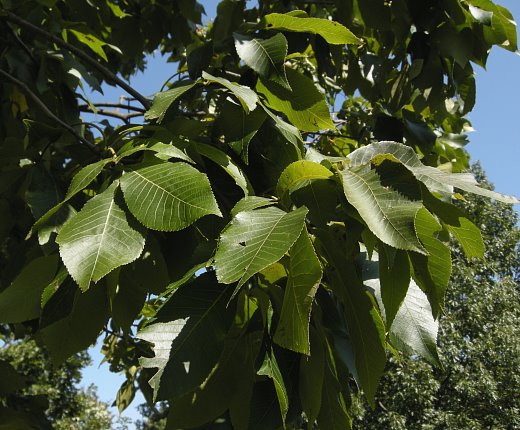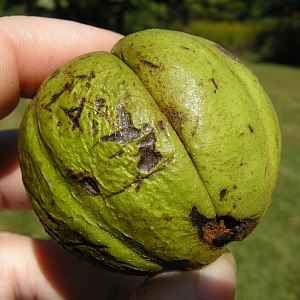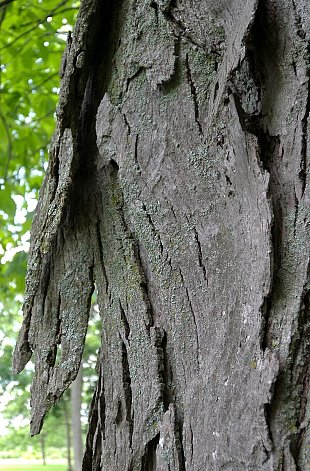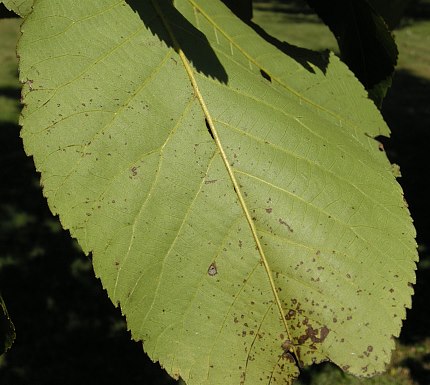
Shagbark Hickory is monoecious, producing separate male (staminate) and female (pistillate) flowers on the same tree. The male flowers are produced in drooping yellowish green catkins near the tips of twigs; these catkins are arranged in groups of 3 (catkins in each group sharing the same basal stalk) and they are 3-6" long. Individual male flowers are less than 1/8" (3 mm.) across, consisting of several stamens and an insignificant calyx; each male flower is partially hidden by a 3-lobed bract. The female flowers are produced in short greenish spikes (about 1/3" or 8 mm. long) at the tips of young shoots; there is typically 2-3 female flowers per spike. Individual female flowers are about 1/8" (3 mm.) long and ovoid in shape, consisting of a calyx and a pistil with spreading stigmata at its apex. The blooming period occurs from mid- to late spring as the leaves develop. The flowers are cross-pollinated by the wind. Fertile female flowers are replaced by nearly sessile clusters of 1-3 fruits that develop during the summer and mature during autumn of the same year. Individual fruits are 1½-2" long and 1½-2" across (or a little less); they are globoid to
 ovoid-globoid in shape. The thick hairless husks of the fruits are light green while immature, becoming brownish black at maturity. Each husk is divided into 4 segments that are indented at their margins, providing the fruit with a ribbed appearance. The nut of each fruit is light tan, ovoid-globoid in shape, slightly 4-angled, and somewhat compressed; the meat of each nut is edible and sweet. The root system has a deep taproot with spreading lateral roots.
ovoid-globoid in shape. The thick hairless husks of the fruits are light green while immature, becoming brownish black at maturity. Each husk is divided into 4 segments that are indented at their margins, providing the fruit with a ribbed appearance. The nut of each fruit is light tan, ovoid-globoid in shape, slightly 4-angled, and somewhat compressed; the meat of each nut is edible and sweet. The root system has a deep taproot with spreading lateral roots.Cultivation: Shagbark Hickory prefers full or partial sun, mesic conditions, and deep loam or clay-loam. Conditions that are either moist (but well-drained) or dry-mesic are readily tolerated. It can be difficult to transplant this tree because of its deep taproot. Growth and development are rather slow. Individual trees begin to produce nuts at about 40 years of age and they may live up to 200-300 years.
Range & Habitat: The native Shagbark Hickory is occasional to common in Illinois, occurring in every county of the state (see Distribution Map). Habitats include upland woodlands, drier areas of floodplain woodlands, lower wooded slopes, bluffs, and edges of limestone glades. This tree is often found in upland habitats that are dominated by oaks, but it also occurs in more mesic habitats where maples and other trees occur. These habitats usually consist of old-growth woodlands that are little disturbed, although some old trees have persisted in more disturbed areas. Shagbark Hickory is more resistant to fire than maples, but less resistant to fire than oaks. Sometimes young seedlings pioneer in burned-over areas.
Faunal Associations: A large number of insects feed on the wood, foliage, plant juices, and other parts of hickories (Carya spp.). They include the larvae of metallic wood-boring beetles, larvae of long-horned beetles, leaf beetles, weevils, larvae of gall flies, plant bugs, aphids, leafhoppers, armored scales, treehoppers, thrips, larvae of sawflies, larvae of leaf blotch miner moths (Gracillariidae), larvae of slug caterpillar moths, larvae of owlet moths (Noctuidae), larvae of prominent moths, larvae of Tortrix moths, and larvae of two butterflies, the Banded Hairstreak (Satyrium calanus falacer) and Hickory Hairstreak (Satyrium caryaevorum). Among the moth species, the Angus Underwing (Catocala angusi), Judith Underwing (Catocala judith), and Residua Underwing (Catocala residua) are thought to feed on Shagbark Hickory exclusively (Wagner et al., 2009). The Insect Table provides a more complete list of these insect feeders.

Vertebrate animals also use Shagbark Hickory and other hickories as sources of food. The sweet edible nuts of Shagbark Hickory are an important source of food for the Fox Squirrel, Gray Squirrel, Red Squirrel, Southern Flying Squirrel, and Eastern Chipmunk; these nuts are also consumed by the Black Bear, Raccoon, White-Footed Mouse, and Deer Mouse (Martin et al., 1951/1961; Hamilton, 1941). Among birds, such species as the Ring-necked Pheasant, Wild Turkey, Crow, Blue Jay, and Red-bellied Woodpecker eat the nuts. These animals help to distribute the nuts to new locations. White-tailed Deer and Elk browse on the foliage and twigs of hickories sparingly, while the Cottontail Rabbit gnaws on the bark of young trees and saplings during the winter (Martin et al., 1951/1961; Schneider et al., 2006). Because hickory trees attract so many insects, they attract many species of flycatchers, vireos, chickadees, gnatcatchers, warblers, tanagers, and other insectivorous birds that prefer wooded habitats. Because of the crevices provided by its peeling bark, Shagbark Hickory in particular provides protective cover for many insects, particularly during the winter. The cavities and peeling bark of this hickory provide summer roost sites for various bats; this includes Rafinesque's Big-eared Bat (Corynorhinus rafinesquii), Northern Long-eared Bat (Myotis septentrionalis), and Indiana Bat (Myotis sodalis); see Martin et al. (2011), Zimmerman (2015), Krynak (2010), and Carter (2003). These bark crevices also provide nesting habitat for a small bird, the Brown Creeper (Certhia americana), while the cavities and branches of Shagbark Hickory provide either nesting habitat or roost sites for the Red-bellied Woodpecker and Eastern Screech Owl (Jackson, 1976; Belthoff & Ritchison (1990).
Photographic Location: Crystal Lake Park in Urbana, Illinois.

Comments: Among the several hickories (Carya spp.) in Illinois, Shagbark Hickory is one of two species that has older trees with very shaggy bark. The other species, Kingnut Hickory (Carya laciniosa), usually has 7 leaflets per compound leaf, while Shagbark Hickory usually has 5 leaflets. A third species, Carya ovalis (Sweet Pignut Hickory), occasionally has somewhat shaggy bark, but it has smaller fruits (less than 1½") than the preceding two species. The commercially important wood of Shagbark Hickory is highly regarded for its strength and hardness: It has been used to make furniture, flooring, tool handles, baseball bats, and other sporting equipment. It is also an excellent source of firewood. With the possible exception of Carya cordiformis (Bitternut Hickory), the range of Shagbark Hickory extends further to the north than other hickories and it has considerable resistance to the harsh conditions of winter. This interesting tree should be cultivated in parks and yards more often than it is.